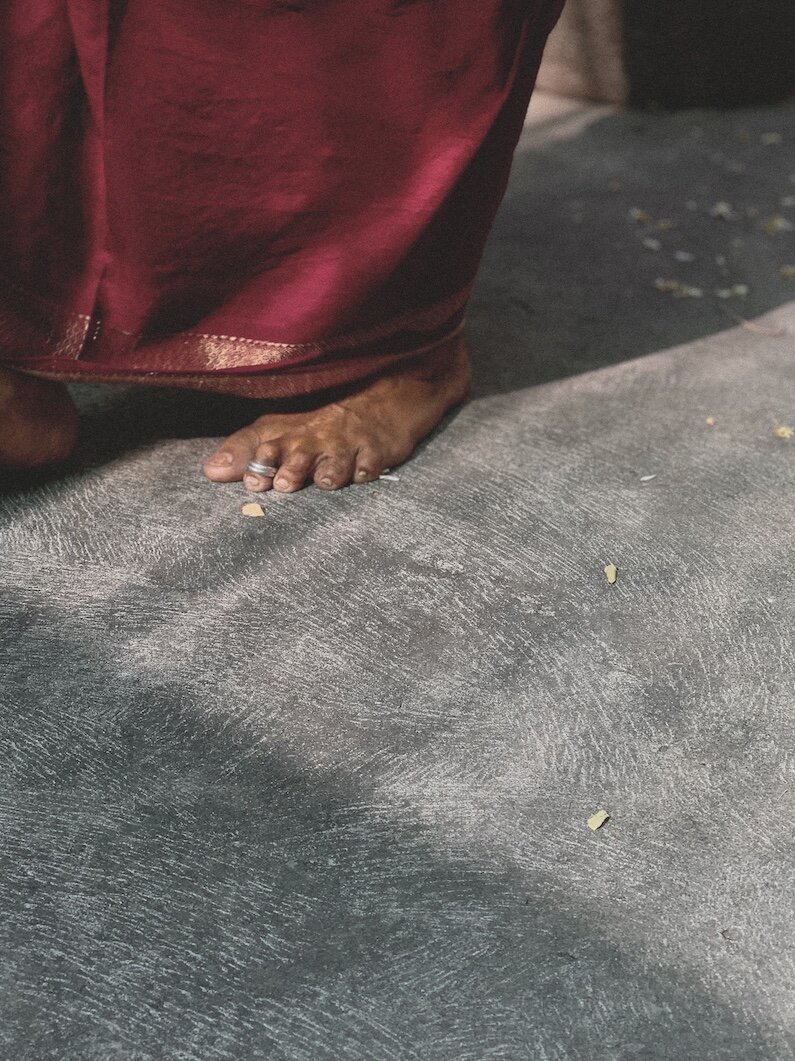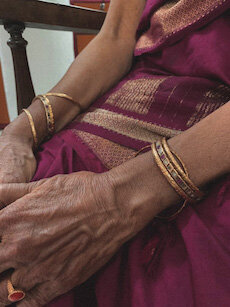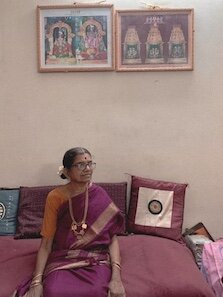Embracing Life in adornment | A day with Padmaja in Chennai
“Even when attending school or college classes, I had to always wear these. When I began going to work, I remember always wearing them.”
Although her earliest memory was from when she was 6 years old, her tradition adorned her first piece of jewellery when she was just a year old. A predominantly South Indian practice of the ear boring ceremony is conducted to officially ordain her as a woman. The girl child is made to wear star shaped diamond earrings to signify the star in which she was born in. “The child is taken to Tirupati to shave off their heads and pierce their ears. The hair you’re born with should be shaved off and offered to the god,” remembers Padmaja maami.
Of modern suffixes
The house Padmaja maami and her husband are living in belonged to her parents which they bought in the 1920s. The home remains to be an extension of the life Padmaja maami leads, one of a pious and meditative character. The name ‘Narasimha Iyengar’ written in red and yellow bejeweled the house’s entrance. Even before we could have a conversation about that wonderful earring she was wearing, I was curious about her very first identity: her name.
“Tell me about your name, who decided to name you Padmaja?” The name ‘Padmaja’ is a variant of the name ‘Padmavati’ which is the official name of the Goddess Lakshmi who resides in Tirupati alongside Lord Venkateswara. “I consider my name to be unique as it signifies a flower and I am very proud of it. I never used my community’s name as a suffix to my name, I always used my father’s initials. Even now, our house is identified by his name as this is the house he lived in.”
Beginning of a new life
“Madisar is worn only by women who are married. It is a very practical piece of clothing, considering it is in fact a free flowing saree. We did not wear any kind of innerwear as such. Madisar made sure it compensated for that.”
The Madisar is a very quintessential part of the Brahmin identity in Tamil Nadu. It is a nine yards long piece of clothing made in all kinds of materials. As is customary, during weddings they wear madisar made out of silk. The madisar has a special drape that looks like a normal saree until the bodice and then takes the shape of a kachcham (pants) below. This makes it a very utilitarian based outfit as it helps women who work around the house and walk distances weather the activities while keeping up their community’s identities.
“Without wearing my madisar I cannot/should not go out of my room. At least that is how my mother lived and my mother in law lived. I have been taught to follow that. With all these years of practice, now it hardly takes five minutes for me to get ready in a madisar everyday.
When I was in Delhi, we lived next to a temple. Everyday when I visited the temple, I would wear a normal saree. One day, the guru there said “how come you are visiting the temple still dressed as a maiden? Shouldn’t you be wearing a madisar?” After that I have never missed wearing a madisar even for a day,” says Padmaja maami. “My madisar keeps me secure. Nobody can dismantle it from my body like Draupadi’s.”
If you have to visit Padmaja maami’s house, do come when you are relatively free to spend time with her. She will not let you leave without relishing her signature Madras filter coffee and indulging in some amazing conversations about beliefs, blouses and baking techniques. I chose a cozy, warm afternoon to spend time with her and her husband in their house in Chennai.
Padmaja maami is the sixth and last daughter of the Iyengar couple from Gopalapuram. She is the most “modern” of them all as she graduated with a masters and was employed until she got married in 1956. For someone like me who’s definition of identity stops right there (or sometimes even with just our Instagram usernames), I was in for quite a ride with Padmaja maami’s story about the derivation of hers.
Born into the Iyengar caste, Padmaja is accustomed to amplify her social identity as a woman in multiple ways. “The earliest memory I have of a piece of jewellery I was made to wear was that of a few thanga valayal (golden bangles). My sisters and I wore a pair on each wrist. We are never to remove it at any cost. Apart from the bangles, a chain and kammal (earrings) were also compulsory.” All these jewellery pieces were made out of gold and are part of their everyday routine dressing.
Of Naths and Nuptials
As we swerved back to the living room after a quick tour of her childhood home, Padmaja maami got back to narrating her life in adornment. “I remember when I hit puberty, I was about 12 years old and to signify that, girls in my community get their noses pierced.”
I am reminded of Shri. M S Subbulakshmi when I think of nose rings. Brahmin women pierce both sides of their noses with glistening diamonds latching onto their mookuthi (nose rings). “My mother used to wear something very similar to that. Her face shone brighter than the sun because of it. To me, she looked like a goddess wearing it,” reminscies Padmaja.
“Mookuthi is a sign of the beginning of womanhood, the pain she is going to endure. My nose piercing occasion was quite uneventful and certainly painful. It’s a prick for a second for a lifetime of heaviness on my face.”
“I got married when I was 25 years old. Marriage subdues my identity and I take up whatever identity my husband has. Marriage changes not just my name, but also my entire lineage since our sect as such is inherently patriarchal that way,” explains Padmaja.
As part of her wedding trousseau comes with it a few life long pieces of jewellery that are also subtle signifiers of her married state. The mangalsutra and the metti (toe rings) are the new additions to her already heavy trunk of jewels. “The thali has a Chanku, sakkaram and a naamam. This will keep adding for every milestone birthday we celebrate for my husband: at 60 years and at 80 years,” explains Padmaja maami.
As she goes through a change in her identity and a shift in belonging, moving into a new family, Padmaja maami’s sartorial adornment also undergoes a significant change. An attire by the name of madisar is introduced in her life.
Signs of surrender
Padmaja maami’s day begins on a note of surrender: “as soon as I open my eyes, I say ‘hari, hari, hari’ and as my feet touch the ground I utter the Panchakanya (Ahalya, Tara, Sita, Mandodari, Kunti and Draupadi) and think of all the great wives in history hoping I lead my everyday life at least a little bit like they did.”
People who belong to the Northern sect of the Vaishnavas like Padmaja maami and her family indicate their belonging to it by extending the line of their naamans north of their foreheads. “Bindis are a huge part of our identity both as a woman as well as a Vaishnava. Our foreheads are never supposed to be bare, we have to have the symbol of god on it always. Personally, I use vermillion kumkum to do a moon like design in the middle of my forehead. I do not prefer any other material to do my daily bindi.”








